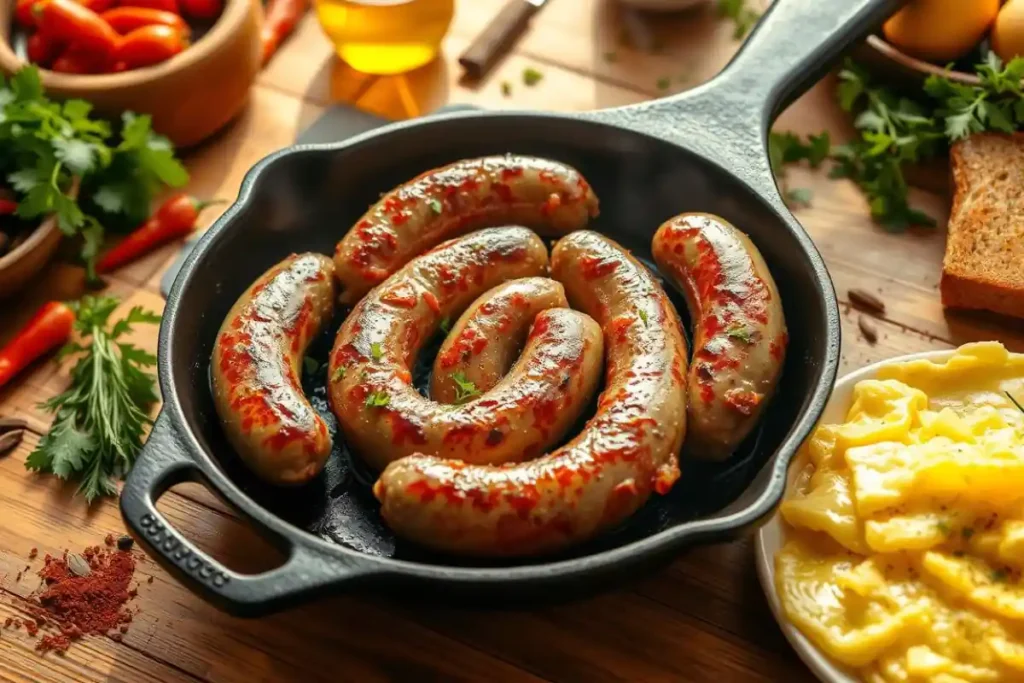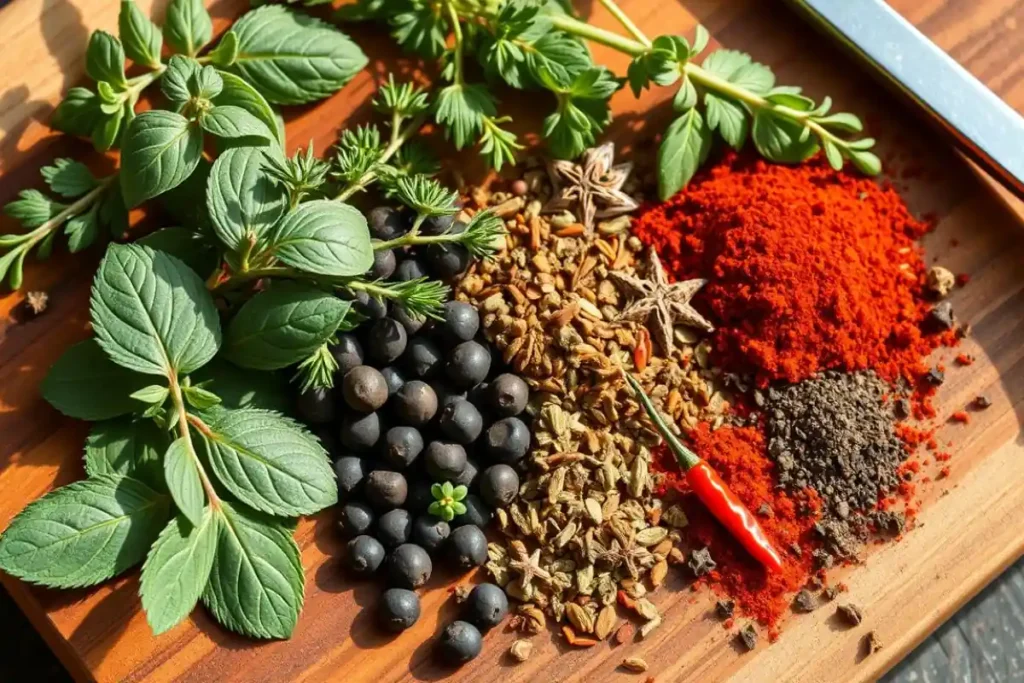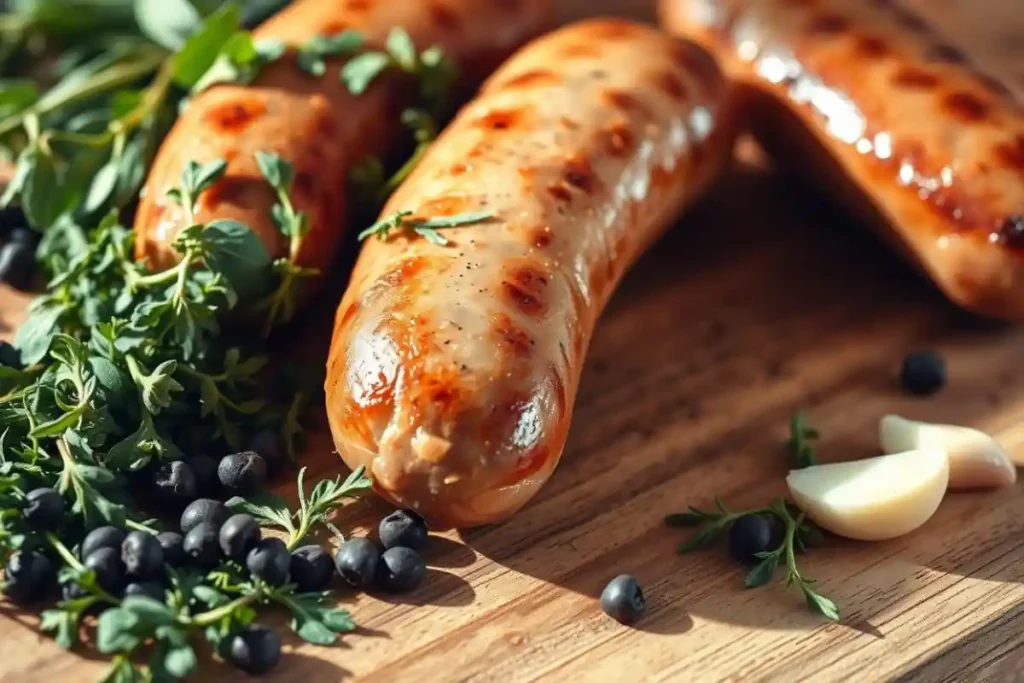Ever wondered why breakfast sausage taste so different from other meats? It’s because of a special mix of herbs, spices, and sweeteners. These ingredients turn regular ground meat into a tasty morning treat.
Breakfast sausage flavor is a mix of many ingredients that work together. You’ll find earthy sage and a hint of brown sugar. Each part is important for that unique morning taste.
Traditional breakfast sausage has a special spice mix. It includes sage, thyme, black pepper, and a bit of sweetness. This mix makes it stand out from other sausages and is a big part of American breakfasts.
Get ready for a journey of flavors. We’ll discover what makes breakfast sausage so special. You’ll learn the secrets behind its irresistible taste.
Understanding the Classic American Breakfast Sausage

Breakfast sausage is a favorite in American food, loved for its history and taste. It’s made from ground pork, giving it a special flavor that people love.
The history of breakfast sausage is rich in American food traditions. It started in the early 19th century as a tasty and affordable meal for many families in the south.
Cultural Roots and Significance
Breakfast sausage is more than food; it’s a cultural symbol of diversity and creativity. The spices used in these sausages share stories of local ingredients and cooking traditions.
- Southern-style sausages feature extra sage and a hint of sugar
- German-influenced versions incorporate caraway and garlic
- Italian-style sausages bring heat with fennel and red pepper flakes
Diverse Sausage Varieties
While pork is the main ingredient, breakfast sausage now comes in many varieties. You can find everything from traditional pork to:
- Turkey sausage for those watching their health
- Plant-based options for vegetarians
- Leaner meat blends with unique tastes
“Breakfast sausage is found in 60% of American households, making it a truly national favorite.” – Culinary Trends Report
Role in American Cuisine
Breakfast sausage is not just for breakfast; it’s a versatile ingredient that makes dishes better. It’s a staple in American morning meals, with a serving size of 2-3 ounces and about 222 calories.
Essential Herbs That Define Breakfast Sausage Flavor

Herbs are key to making the perfect breakfast sausage. Sage seasoning is the main ingredient that gives it a unique taste. It adds a woodsy, slightly peppery flavor that makes the sausage special.
The mix of herbs in sausage spices is like a symphony of flavors. Sage is the main player, but other herbs add their own touches:
- Thyme: Adds an earthy, slightly minty undertone
- Rosemary: Provides a pine-like, aromatic complexity
- Marjoram: Introduces a delicate, sweet herbal note
Both professional chefs and home cooks know the secret to great breakfast sausage. It’s all about balancing these herbs. Fresh herbs make a big difference, adding a brighter, more vibrant taste.
“The right herb blend can transform simple meat into a culinary masterpiece.” – Culinary Expert
When picking your sage seasoning, look for high-quality, fresh herbs. They will give your breakfast sausage taste that authentic, mouth-watering flavor. This flavor is a morning tradition in many American kitchens.
The Magic of Sage and Thyme Combination
Making the perfect breakfast sausage is an art. It’s all about balancing sage seasoning and sausage spices. Sage and thyme turn simple meat into a tasty breakfast treat.

Finding the Perfect Herb Ratio
When using sage, being precise is important. Experts suggest:
- 1.5 teaspoons of chopped fresh sage per pound of meat
- ¼ teaspoon of fresh thyme
- ½ teaspoon of fresh ground pepper
Fresh vs. Dried Herb Considerations
Choosing between fresh and dried herbs changes the flavor. Fresh herbs give a stronger taste. Pro tip: Use less dried herbs, about one-third less, to keep the flavor right.
Balancing Herb Flavors
“The secret to great sausage is understanding how herbs dance together on your palate.”
Getting the right mix of herbs is key. Sage adds a strong, earthy flavor. Thyme brings a soft, minty taste. The goal is to balance them well.
Try adjusting the sage seasoning to your liking. Start with the suggested amounts and tweak them to fit your taste.
Sweet Elements: Maple Syrup and Brown Sugar
Exploring what makes breakfast sausage special, we find that sweeteners are key. Maple syrup and brown sugar are the magic that turns simple meat into a flavorful breakfast treat.
These sweet elements add a special touch to the sausage’s taste. They balance the savory meat with a hint of sweetness. Both home cooks and chefs use them to make their sausages stand out.
- Maple syrup adds a rich, natural sweetness
- Brown sugar brings a deeper, caramelized flavor
- ¼ cup of real maple syrup can greatly enhance the taste
“The magic of breakfast sausage lies in its perfect balance of sweet and savory,” says chef Michael Roberts.
The sweetness of the sausage pairs well with morning favorites like pancakes and French toast. The sugar also helps create a golden-brown crust during cooking.
When picking sweeteners, keep these tips in mind:
- Opt for pure maple syrup for the best flavor
- Dark brown sugar is great for deeper caramel notes
- Start with a small amount and adjust to taste
Pro tip: The recommended serving contains just 1g of sugar, making it a balanced addition to your breakfast plate.
What Gives Breakfast Sausage That Distinct Taste ?
Breakfast sausage has a unique flavor that stands out. This is thanks to a special mix of spices and seasoning techniques passed down through generations.
Core Spice Blend Components
The taste of breakfast sausage comes from a mix of spices. These spices create a flavor that’s hard to forget. Here are the main ingredients:
- Black pepper
- Cayenne pepper
- Garlic powder
- Onion powder
- Sage
- Thyme
Traditional vs Modern Seasonings
Sausage-making has changed a lot. Old-fashioned breakfast sausage used simple spice blends. Now, there are new flavors that mix tradition with modern twists.
| Traditional Seasonings | Modern Seasonings |
| Salt | Smoked paprika |
| Black pepper | Chipotle powder |
| Sage | Exotic herb blends |
| Minimal spice mix | Complex flavor layers |
Regional Flavor Variations
Breakfast sausage taste different in different parts of the U.S. Southern recipes are often spicier. Midwestern versions are milder and more traditional.
“The art of breakfast sausage is all about balancing spices to create that perfect morning flavor.” – Culinary Experts
To understand breakfast sausage’s unique taste, we must see the balance of spices, meat quality, and local cooking traditions.
The Role of Meat Selection in Flavor Development
Choosing the right meat is key to making tasty breakfast protein. Traditional breakfast sausage uses ground pork. It has a rich flavor that many love.
The fat in the meat is important for taste and texture.
When picking meat for breakfast sausage, think about these things:
- Fat-to-lean meat ratio (usually 25-30% fat)
- Meat quality and freshness
- Flavor intensity of the protein
Pork seasonings pair well with ground pork because of its fat. The traditional 75% lean to 25% fat ratio makes sausage juicy and flavorful. While pork is the top choice, turkey and chicken are good for those watching their health.
“The meat you choose is the foundation of your sausage’s flavor journey.” – Culinary Experts
Other meats change your sausage’s taste. Turkey sausage is leaner, and chicken is milder. Adding a bit of pork fat can improve taste and texture.
Regional tastes also play a part. Southern recipes often use fattier cuts. Coastal areas might try different proteins. Your meat choice shapes your sausage’s flavor.
Texture and Processing Methods
Making the perfect breakfast sausage is more than just picking ingredients. The texture and how it’s processed are key to that delicious taste and satisfying bite you love.
Grinding Techniques That Make a Difference
Grinding is vital when making smoked sausage. It’s best to chill your meat for 30 minutes before grinding. This helps keep the fat from melting, making the texture and flavor more even.
- Use cold meat (around 40°F) for optimal grinding
- Chop meat into small cubes before grinding
- Keep grinding equipment and meat very cold
Casing vs. Patty Formation
There are two main ways to make breakfast sausage: with casings or as loose patties. Patties brown better, while casings give a traditional sausage feel.
Optimal Fat Content for Juicy Sausages
Fat is what makes sausages tasty. Sausage meat usually has a 70/30 fat-to-meat ratio. But, store-bought ground pork can be too lean, leading to dry sausages.
“The right fat content transforms a good sausage into an extraordinary one.” – Culinary Experts
Today, sausage makers are trying new things like carrageenan and xanthan gum. These help keep sausages juicy and tasty, even when they’re cooked.
Making Homemade Breakfast Sausage Seasoning
Making your own breakfast sausage seasoning is simple. Just a few ingredients can turn ground meat into a tasty breakfast treat. The trick is to mix herbs and spices right to get that classic sausage taste.
To create your sage seasoning mix, you’ll need:
- 1 tablespoon ground sage
- 1 teaspoon salt
- ½ teaspoon black pepper
- ½ teaspoon garlic powder
- ¼ teaspoon dried thyme
- ⅛ teaspoon smoked paprika
- Optional: ⅛ teaspoon red pepper flakes
Pro tip: Always use fresh, high-quality spices for the best flavor profile.
When making your seasoning, mix all dry ingredients well. Use about 3.5 tablespoons of seasoning for every pound of ground meat. This blend works great with pork, chicken, or turkey.
“The key to great sausage is in the seasoning – make it your own!” – Home Cooking Expert
Storing your seasoning is easy. Keep it in an airtight container in a cool, dark spot. It will last up to 3 months, so you can enjoy your custom seasonings anytime for a tasty breakfast.
Storage and Preservation Tips
Storing cured meats and smoked sausage right is key for keeping flavors and food safe. Each type of sausage needs its own way to stay fresh and tasty.
Here are some tips for storing fresh sausages:
- Refrigerate fresh sausages for 1 to 2 days max
- Freeze fresh sausages for 1 to 2 months
- Never leave sausages at room temperature for more than 2 hours
For cooked smoked sausage, the storage rules change a bit:
- Refrigerate cooked sausages for 3 to 4 days
- Freeze cooked sausages up to 4 months
- Store precooked sausages (unopened) up to 2 weeks in the fridge
“The key to preserving sausage quality is controlling temperature and minimizing exposure to air.” – Culinary Preservation Expert
Hard sausages like salami have their own storage method. Unopened hard sausages can stay in the fridge forever. But once opened, they last about 3 weeks.
Always watch for signs of spoilage like:
- Grayish or greenish color
- Sour or rancid smell
- Slimy texture
- Visible mold growth
Pro tip: Keep your fridge at or below 40 degrees Fahrenheit. This helps keep sausages fresh and safe.
Alternative and Plant-Based Options
Vegan alternatives are getting better at mimicking the taste of breakfast sausage. Now, we can enjoy the classic sausage taste through plant-based methods.
Looking into plant-based breakfast sausages shows a wide range of choices. These options offer the taste of traditional sausage but with health benefits.
Vegan Substitutes Revolutionizing Breakfast
Top vegan brands have changed the breakfast scene with amazing alternatives:
- Impossible Foods: Most realistic meat-like taste
- Beyond Meat: Spicy and traditional flavor profiles
- Gardein: Budget-friendly option
- Lightlife: Classic sausage experience
Flavor Matching Techniques
Creating real sausage flavor needs special ingredient mixes. Makers use:
- Textured vegetable protein (TVP)
- Mushroom-based umami flavors
- Spice blends mimicking traditional recipes
- Nutritional yeast for depth
Nutritional Considerations
| Brand | Protein (g) | Price | Key Features |
| Impossible | 11 | $5.99 | Most meat-like |
| Beyond | 10 | $5.49 | Spicy options |
| Lightlife | 9 | $4.99 | Classic flavor |
Vegan breakfast sausages have as much protein as traditional ones. They’re great for those who want a plant-based option without sacrificing taste.
Conclusion
Exploring what makes breakfast sausage so special is a fun journey. It’s not just about the ingredients. The taste comes from a mix of spices and how it’s cooked.
Herbs like sage and thyme add depth, while sweeteners like maple syrup add a hint of sweetness. Whether you like classic pork or try turkey, chicken, or plant-based options, each one has its own flavor. This makes breakfast sausage a game-changer for your morning meals.
Now, you can cook sausage with a better understanding of how to do it right. With about 15-20 grams of protein per serving, you can grill or pan-fry it. This lets you enjoy it in many ways, making your breakfasts more exciting.
Breakfast sausage is more than just food; it’s a way to share special moments. It brings people together with its warm, comforting taste. Whether you stick to meat or try something new, there’s a sausage out there for you to enjoy.
FAQ
What makes breakfast sausage taste different from other types of sausage ?
Breakfast sausage has a unique flavor from herbs and spices, with sage being key. Sage, thyme, and a bit of sweetness from maple syrup or brown sugar make it special. This mix sets it apart from other sausages.
Is pork the only meat used for breakfast sausage ?
No, pork is not the only meat. You can find turkey, chicken, and even plant-based options. Each offers a unique taste and texture.
Why is sage so important in breakfast sausage ?
Sage gives breakfast sausage its classic, woodsy flavor. It’s the main herb that makes the sausage taste so familiar and loved.
Can I make my own breakfast sausage seasoning at home ?
Yes, you can! Mix dried sage, thyme, salt, black pepper, and sweeteners like brown sugar or maple syrup. This way, you can adjust the flavor to your liking.
How do sweeteners contribute to breakfast sausage flavor ?
Sweeteners like maple syrup and brown sugar add a touch of sweetness. This sweetness balances the savory herbs and spices. It’s what makes breakfast sausage so unique and pairs well with other breakfast foods.
Are there vegetarian or vegan breakfast sausage options?
Yes, there are plant-based alternatives. They’re made from soy, pea protein, and vegetables. These options try to mimic the taste of traditional breakfast sausage with similar flavors.
How should I store breakfast sausage and its seasoning ?
Keep fresh breakfast sausage in the fridge and use it within a few days. Or, freeze it for longer. Store dry seasoning mixes in an airtight container in a cool, dry place to keep their flavor.
What’s the difference between breakfast sausage links and patties ?
Links are shaped like little sausages, while patties are flat and round. Both can have the same flavor, but links are encased and patties are not. Cooking methods might differ slightly.

